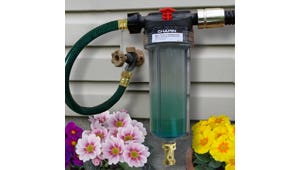Beat Perennial Weeds
Early fall is a good time to battle perennial weeds, such as Canada thistle, field bindweed and quack grass. Read about controlling perennial weeds.
Annual weeds typically reproduce from seed, so if you dig them up or apply an herbicide before they set seed, they probably won’t reappear. Perennial weeds, though, are far more challenging. They not only reproduce from seed, but they also regenerate vegetatively—similar to a lily growing from a bulb or a potato from a tuber. For example, Canada thistle and field bindweed grow predominantly from extensive creeping root systems, and quack grass and Johnsongrass propagate from underground stems called rhizomes.
For effective perennial weed control, timing is everything. Underground bulbs, tubers, roots and rhizomes contain the carbohydrate reserves the plants need to grow. Non-chemical treatments like pulling and hoeing work best after the plants flower, when their reserves are low and the plants, therefore, are at their most vulnerable. Know, though, that you’re in for a long battle. Studies show it can take years of regrowth and pulling before the plant uses up its underground stores and starves.
As a result, many gardeners choose to use herbicides for perennial weed control. If you go that route, you’ll find that late summer and early fall are the best times for treatment. Cooler nighttime temperatures in these seasons signal the weeds to send most of the carbohydrates they produce from photosynthesis down into their root system. If you apply an herbicide during this period, it is more likely to be carried into the roots, from where it can destroy the plant.
For optimal results, water perennial weeds so they are healthy and growing before you treat them. That may seem counterintuitive, but science shows it’s the best approach. If a weed is water-stressed and not growing actively, it won’t photosynthesize as much. Less carbohydrate—and less herbicide—will be translocated into the root system.
Unfortunately for gardeners, spring is one of the worst times to tackle perennial weeds. Carbohydrate reserves are generally highest because the plant has yet to use them to flower and produce seed. If you want your garden to look pristine, simply cut back the weeds periodically and make plans to treat them in the fall.
One important thing to note: Follow-up is critical. Don’t expect to control any perennial weed with a single treatment. No herbicide can do that. Use a fall application as the starting point for your perennial weed management program and plan to repeat the process the following year. If you eschew herbicides, commit yourself to repetitive pulling. Monitor any persistent weed patches closely, and you’ll soon have them under control.
Image courtesy the UMass Extension Weed Herbarium
Get an illustrated guide to 5 fall gardening tasks for under $5
See our popular CD, 10 Years of Horticulture: 1997–2006







